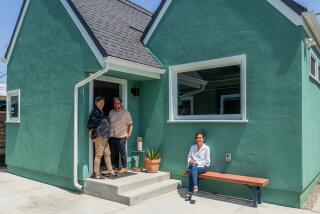Architects Suggest Alternative Housing Styles
It sometimes seems, proponents of alternative housing say, that in an era in which every other institution and tradition is changing, the housing industry is on hold. As Dana Cuff, a USC expert on architectural environment and culture, put it: âThe only radical change in houses in the last 50 years has been removing the wall between the dining room and the kitchen.â
Home builders recognize the architectural time warp. Assessing the domestic housing field, National Assn. of Home Builders president Dale Stuard acknowledged: âIf you just take a look at the outside, houses havenât changed a lot in 200 years. Weâve moved the kitchen and plumbing inside--those were the major changes.â
Trying to fit changing households into unchanging houses has resulted in what architects Charles Durrett and Kathryn McCamant have called the problem of the âmis-housed.â And a host of architects, sociologists, planners and other social scientists are beginning to call for a re-examination of the single family dwelling, and a search for new options.
Some Progress Seen
What such experts are finding is a lot of theoretical thinking, and at least a few architects and builders who are âdoing some interesting thingsâ on a limited scale.
USCâs Cuff is co-author of a new book titled âArchitectsâ People,â a series of interviews with contemporary architects exploring their ideas about the people who will live in their buildings.
âOne of the strongest themes in their vision of the social world is the need for order,â she writes.
âMany architects see the world as a disordered place,â she explained in a recent interview, âand in architecture, as in other fields, one reaction to this is a collective conservatism that manifests itself as nostalgia.â
This conservatism, Cuff said, works against introducing housing innovation on any large scale.
âIf the building professions are dominated by older men, they are naturally more likely to have traditional families and therefore not understand emerging household needs.â
More Open Thinking
But Cuff, who has a Ph.D. in architecture from UC Berkeley, believes a growing diversity in the architectural ranks will help to open up thinking: âI think it is inescapable that people have to figure out that both Mom and Dad work these days, and we donât have anybody at home. We have to think about communities, not just housing, and it has to be within a broad economic grasp.
âWe shouldnât be looking for one solution like a tract home,â she said. âWe should be looking for 20 different solutions.â
She cites a few experiments that have surfaced over the past few years: Houses built over garages, âminglesâ for two or more single people, âcongregateâ living, combining a home with health care, for the elderly.
âNone of these is easy,â she added. âThis question of why the house hasnât changed along with our population patterns is a complex one. The housing market is stifled by a whole landscape of connecting issues--zoning, parking regulations, transportation systems, jobs, financing.â
Three Options Emerge
The idea that we need new kinds of spaces for new families also has intrigued New Jersey Institute of Technology environmental psychologist Karen Frank.
Frank, who teaches in the Instituteâs School of Architecture, has just completed a book titled âNew Households, New Housing,â an overview of alternative housing in this country and Europe, a subject she spent two years examining with the help of a National Science Foundation grant. In the book, she and co-editor Sherry Ahrentzen focused on three emerging housing types.
--Collective housing. âThis is not shared housing, but housing in which you have your own independent unit, including your own kitchen, and you have additional common space, which makes it different from a commune. There is a lot of cohousing in Scandinavia. And we also talk about historical types such as apartment-hotels where families could order room service food or eat in the dining room.â
--Housing for single parents. âThe expectation is that single parents will need more support, both from neighbors and day care centers. And it needs to be located with easy access to sources of employment and social services. There are a few examples either being designed or under construction.â
--Single-room occupancy housing. âThis is SRO, which is often being provided by renovating former hotels to serve as long-term housing for single people. Again this was quite an accepted form of housing in the early 20th Century, especially for unmarried men who could live in pleasant, well-managed hotels. Now there is a great interest in renovating buildings for SRO, and not just for the very poor.â
Market May React
Frank said she and Ahrentzen âdiscovered more projects than I expected, but there is still not enough going on.â Frank said that, although it seems to be stuck on the single-family dwelling, âif the market sees some financial advantage in alternative housing, there is no doubt it will eventually react.â
Samuel Aroni, UCLA professor in the School of Architecture and Urban Planning, agrees.
âThe problem is that of adjusting to the way the housing market works,â he said. âMost of us donât have our shoes or clothes made to order, we must use what is made by producers.â
He suggests, however, that the producers can be nudged.
âDevelopers react to the market, and the minute the market seems to be changing, so will the developers.â The growing number of elderly people, for instance, has prompted creation of a number of new housing options.
Middle-class buyers should be more imaginative, he says. âIf there are enough people, they can approach builders with what they want. They can get a group, buy one lot or two lots, put in their own equity, whatever.â
In short, the countryâs mis-housed should show a little initiative, he said.
âThatâs an American trait.â
More to Read
Sign up for Essential California
The most important California stories and recommendations in your inbox every morning.
You may occasionally receive promotional content from the Los Angeles Times.






